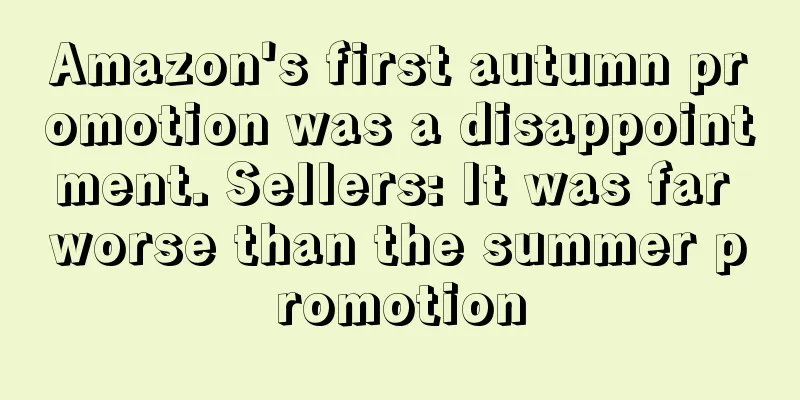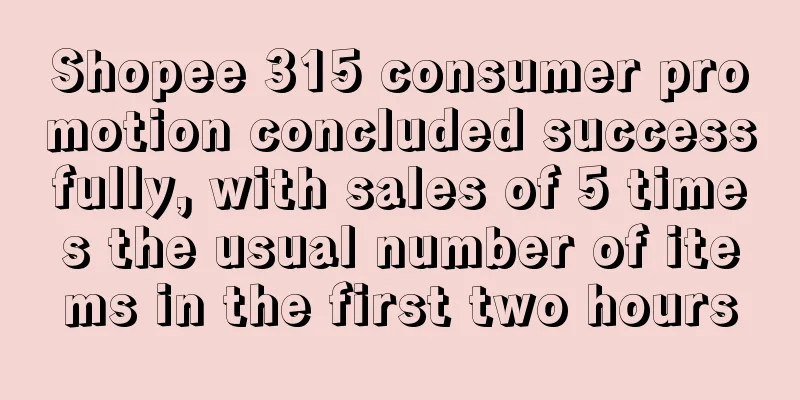Amazon's first autumn promotion was a disappointment. Sellers: It was far worse than the summer promotion

|
Sellers are eager to try out this autumn promotion, which is defined as "Prime Day 2.0", and even organize employees to watch the store all night. According to the current feedback, some sellers' orders have increased, but the majority of orders are mediocre or worse than usual. At the same time, due to the requirements of discount setting, some products have increased sales but their profits have decreased year-on-year, and advertising costs have increased significantly.
Considering the profit margin and the subsequent Black Friday and Cyber Monday promotion, many sellers did not put in too much effort in the promotion and only tried it out. From the actual sales situation, sellers believe that the effect of this autumn promotion is far from that of the summer promotion.
Amazon's autumn sales are a flop
Amazon previously said that in order to give Prime members the opportunity to enjoy holiday shopping season great deals early and open up new growth opportunities for sellers, it launched this new promotion, which will last for 48 hours.
A group of sellers seized this opportunity decisively. One operator said that the second day after the new product was launched, there was a big sale, and it seemed that the number of orders would exceed 100, which made him very happy; another operator's flash sale was allocated to the 11th, and the number of orders reached 5 times the usual number. Another seller won everything, "I estimate that the sales of our products that did not participate in the event have doubled. The number of orders participating in the event is already 3 times that of yesterday. It is estimated that the sales of this year's participating events will be 6 times that of yesterday."
But positive feedback was very limited, and more sellers had their expectations dashed. They once suspected that Amazon only notified the sellers of the event but forgot to tell the buyers.
An operator revealed that the company required them to stay up all night to watch the store during the two-day member day. Unfortunately, there were few orders and they had to go back to work the next day. His colleagues were puzzled when they heard this, "What can you do by staying up all night? Press F5?"
Indeed, many sellers were in disbelief when they saw the sales data. After all, the big promotion overdrew the number of orders before the event, and many people also did a combination of promotions and flash sales. As a result, the number of orders was basically the same as usual, and sales even decreased. After taking into account the advertising fees and event costs, they also lost some profits, which was naturally hard to accept.
A small seller revealed that he received about 80 orders a day on the summer membership day , but on the first day of the promotion, the number of orders was even lower than usual. Advertising expenses exceeded the budget and ACOS was off the charts. Moreover, because of the discounts, the sales volume of the same number of orders was much less. "Advertising costs soared, prices were lower than usual, and the number of orders did not increase much. It was just a welfare." Someone concluded.
Another seller said that the selling prices of some of his products were too low on weekdays, and he could no longer meet the minimum 20% discount requirement, so he missed the event. To his surprise, the orders for the products he had registered for the autumn promotion were even worse than usual. However, during the July Member Day, his orders doubled.
Neither the traffic nor the number of orders can give people a sense of the atmosphere of a big sale. The only thing that has a promotional atmosphere is the surge in advertising fees. Sellers have truly felt that the conversion rate is plummeting despite the crazy advertising. Such promotion results make them miss the summer membership day promotion very much:
“The average price is much lower than the summer Prime period, and the order volume is less than half of that time.” "Only halfway through summer, I'm starting to doubt myself." "It increased by about one-third, but not as much as in summer." “It’s only one-fifth of summer now, and the advertising conversion rate is average.”
This is not surprising. Prime Day's promotional status is similar to Double 11, and its popularity and buyer impression score are not comparable to a newly created event. During Amazon Prime Day 2022, Prime members purchased more than 300 million items worldwide, with more than 100,000 items purchased every minute.
In addition, during big promotions such as Member Day, there are often episodes where discounts are set incorrectly, and this time is no exception. In the past two days, the following screenshot has been widely circulated in the industry.
Figure 1
This "blood loss" package is incredible to sellers. Some people admire that such a setting can actually be successful, which can be said to be the ultimate charity; but more peers are worried, thinking that the seller's original intention was to offer a "20% discount" but made a mistake in operation. The autumn promotion is the first time, and the event label is the words "Prime Early Access" on a blue background. During this event, there are many promotional products on Amazon with both blue and green labels, which makes people sweat.
In addition to setting errors, some people even go so far as to increase the discount to 90% or above for the purpose of clearing stock or boosting rankings, which is beyond the reach of others.
Some sellers joked that this autumn promotion was a collective price reduction under the premise of unchanged traffic. Therefore, those who did not participate in the promotion had a price disadvantage. For example, one seller's orders dropped sharply because the sellers at the top of the ranking were those who held promotions or had 5%-15% coupons.
Overall, the promotion atmosphere was weak, and the launch ceremony and order sharing that are common during Prime Day were rarely seen. In addition to the decline in consumer purchasing power, new gimmick promotions, the peak season has not yet arrived, and insufficient publicity are also factors for its poor performance. Even some sellers are not clear about the event date and label, which shows that this hastily promoted event was not well prepared.
Despite this, some categories did see growth. According to market research firm Numerator, the average order size in the first 16 hours of the promotion was $44.37. The best-selling items were Amazon gift cards, Echo Dots and Melissa & Doug brand toys. The categories that consumers bought the most were household essentials, health and beauty, and shoes and apparel.
Autumn promotion may affect Black Friday and Online Monday event prices
It is predicted that more than 30% of American consumers plan to shop at Amazon's autumn promotion, and the average expenditure of American families will exceed $200. Consumers will buy candy and decorations to welcome Halloween. Before the promotion began, many sellers also had high hopes for it and were not stingy with sales discounts.
However, sellers now have another concern, worrying that the prices during the autumn promotion will affect the subsequent Black Friday and Cyber Monday prices. This concern is justified.
In the previous autumn promotion proposal, Amazon required that Prime-specific coupons be at least 20% off the current price; Prime-exclusive discounts should be between 20% and 20% off the current price, equal to or lower than the lowest price in the past 30 days, and Prime-exclusive discount prices must be 5% lower than the reference price. The overall discount is not small.
Participating in the Prime Early Bird Day flash sales may affect the prices of Black Friday and Cyber Monday events. Amazon mentioned that the flash sales prices for Black Friday and Cyber Monday in some sites such as the United States and Japan must be lower than the lowest prices this year , which includes the usual flash sales prices and the big promotion flash sales prices.
This year, Black Friday and Cyber Monday will be held on November 25 and November 28 respectively. The latest warehouse entry time for Black Friday in the United States is November 2, and the latest warehouse entry time in Europe is November 4. Most sellers have prepared goods in advance to ensure that the goods can be delivered to Amazon warehouses before the specified date.
In terms of promotion, Amazon reminds sellers not to modify the price information of the promotional ASIN at will before and during the promotion . It is recommended to use only one promotional tool for the same ASIN at the same time to avoid discount stacking and affecting sales profits. If the profit is sufficient and the seller wants to participate in multiple promotions, he must be careful not to stack the Prime exclusive discounts, otherwise it will trigger suppression.
After the autumn promotion, sellers are more looking forward to Black Friday and Cyber Monday. After all, the appeal of traditional festivals is incomparable. In 2021, Amazon's Black Friday and Cyber Monday broke records, with hot sales in categories such as home furnishings, toys and clothing. Shanxi Xinhe Industrial Co., Ltd., which specializes in sports products such as yoga mats and dumbbells, said that the sales of its main products during Black Friday reached 8 times the usual level.
Walmart and Target also joined the game, and October became an unprecedented promotion month
Amazon's two-day fall sale stimulated earlier holiday season sales. In order to gain more market share, Walmart, Target, Macy's and other competitors have also begun to join the ranks of early price cuts to attract consumers with tight holiday budgets. This October has become an unprecedented promotion month!
Amazon 's October fall sale features big discounts on Amazon devices such as Kindle, Echo and Fire TV, as well as its own-brand clothing, similar to Prime Day in July. In addition to Amazon's own brands, other deals include 35% off headphones from Sony and Bose, some laptops from Dell and HP, and 15% off Peloton bikes.
Unlike the July Prime Day promotion, this month there will be more gift discounts, such as products from brands such as Hasbro, Lego, Barbie and Sony. Some Christmas products are also offered at a 60% discount in the autumn promotion.
However, studies have shown that Amazon's autumn promotion deals are not as attractive as they seem, and some products are often increased in price before discounts. For example, a vacuum cleaner was originally priced at $250, and the price was increased to $300 before the promotion. On the day of the promotion, a slash was drawn through the $300, showing the discounted price as $275. In the end, consumers thought they were enjoying a discount, but in fact it was not.
Regardless of the promotional price, Amazon has effectively targeted consumers who want to place orders in November by holding this massive fall promotion .
But Amazon's competitors are not sitting still, with retailers such as Walmart and Target also launching their own promotions this month.
Walmart : The "Rollbacks and More" event will be held from October 10th to 13th. The promotion starts before the Amazon sale and ends after the sale. Some gifts, electronic products, household items, toys and clothing are on sale.
Target: Deal Days kick off Oct. 6 with promotions in categories including furniture, electronics, beauty, apparel, toys and sporting goods. Shoppers can also take advantage of Walmart's price match guarantee, which means items purchased between Oct. 6 and Dec. 24 are eligible for a price adjustment if the price drops by Christmas Eve.
Macy's: The "Fab Fall" sale runs through Oct. 10 and offers savings of up to 60% for loyal members, plus extra cash bonuses.
Kohl's and Best Buy: 48-hour sales on the same day as Amazon's. Kohl's offers an additional 20% off already discounted items.
“This year retailers are trying to reach consumers earlier, with the idea being that the early bird catches the worm,” said Carol Spieckerman, president of consulting firm Spieckerman Retail.
The early start to the holiday shopping season is not surprising. Major retailers such as Target and Walmart have been offering deep discounts for months to clear out excess inventory that has piled up as consumers cut back on spending.
Figure 2
Major retailers are bringing forward their promotions in the hope of attracting shoppers to place orders before Black Friday and Cyber Monday, because consumers are more worried about price increases amid inflation.
In fact, a recent report from market research firm Numerator shows that many consumers have already started buying holiday gifts, with nearly a third of people planning to shop during this round of fall sales.
Another report from the National Retail Federation found that about 44% of shoppers believe it is better to buy gifts now because they may be more expensive before the end of the year. Apparently, the fear that prices will continue to rise has stimulated more people to buy in advance.
Joseph Feldman, an analyst at Telsey Advisory Group, said: "Middle- and high-income consumers are more likely to buy during the autumn promotion period, seize discounts and enjoy products in advance, but for lower-income consumers, they may postpone consumption and buy more products that they actually need."
U.S. consumers are expected to slow their holiday spending this year, spurred by early discounts and inflation.
U.S. holiday online sales growth of 2.5%, the lowest since 2015
Data from Adobe Analytics shows that online sales in the United States are expected to reach $209.7 billion during this year's holiday season , an increase of only 2.5%, the slowest growth rate since 2015.
Adobe's online shopping forecast for the 2022 holiday season covers the period from November 1 to December 31, 2022. It predicts that more consumers will shop early this year because Amazon's fall promotion will take place before the holiday season begins.
This summer's Prime Day event boosted online sales across the retail industry, with online spending reaching $73.7 billion in July, up 20.9% year-on-year. The fall promotion will also attract some consumers to shop early, affecting the performance of the holiday season.
It is worth noting that this year's holiday season will also be affected by the uncertain economic environment as shoppers deal with rising prices for food, gas, housing and borrowing costs.
Cyber Monday is expected to remain the biggest shopping day of the season and year, generating a record $11.2 billion in sales, up 5.1% year-over-year. In contrast, online sales on Black Friday are expected to grow just 1% year-over-year to $9 billion, while Thanksgiving sales are expected to fall to $5.1 billion, down 1% year-over-year.
As online shopping becomes a more common activity and discounts on online platforms run almost throughout the entire shopping season, major shopping promotion days such as Black Friday and Cyber Monday will become less and less important.
Adobe expects Cyber Week (Thanksgiving to Cyber Monday) to generate $34.8 billion in total sales revenue, up 2.8% year-over-year, accounting for 16.3% of the entire quarter, down from 16.6% in 2021.
“The holiday season will look different this year, with early discounts in October driving spending around Cyber Week,” said Patrick Brown, vice president of marketing at Adobe. “While we expect online spending to grow in the single digits this quarter, consumers spent more than $590 billion online from January to August this year, an 8.9% increase, which highlights the resilience of e-commerce demand.”
Figure 3
During this year's holiday season, Adobe expects electronics, apparel and groceries to be the three hot-selling categories, contributing $103.8 billion in sales this quarter, which is almost half of the $209.7 billion. These three categories have become the main drivers of online revenue growth.
Specifically, the growth of the three most popular categories is as follows:
Electronics: will generate $49.8 billion in online sales, up 2.9% year-on-year. Competition in electronics is fierce, and holiday discounts are large, so they will generate large sales. The deep discounts on these products will attract enough shoppers, but will also affect sellers' profits.
Clothing: Shoppers are expected to spend $40.7 billion on online clothing this season. As the anxiety related to the epidemic subsides, more consumers are beginning to dress up, but as people spend more time at home, some comfortable home clothes may have good sales.
Groceries: This category has seen a boom in online sales in 2020. This quarter, as consumers plan holiday meals, online grocery sales will generate $13.3 billion, a year-on-year increase of 10.5%.
In addition, this year's holiday season discounts will hit a record high of 32%, as major retailers have to consider clearing inventory and responding to the current situation of weak consumption.
In terms of specific categories, discounts on computers, electronic products and toys will hit record highs, with computer discounts expected to be as high as 32%, up from 10% last year; electronic product discounts will reach 27%, up from 8% last year; and toy discounts will reach 22%, up from 19% last year.
Other products with big discounts include: TVs at 19%, clothing at 19%, appliances at 18%, sporting goods at 17%, and furniture and bedding at 11%.
The biggest discounts of the holiday season are expected to occur between Thanksgiving and Cyber Monday. Thanksgiving ( November 24) will be the best day to buy electronics; Black Friday (November 25) will have the best deals on TVs; the day after Black Friday (November 26) will have the biggest discounts on toys; Sunday (November 27) will likely have the biggest discounts on clothing and sporting goods; and appliances will have the highest discounts on December 1.
Although the best prices will be available between Thanksgiving and Cyber Monday, the earliest discounts will appear in the second week of October, with discounts of up to 15%. In the weeks after Cyber Monday, discounts will be as high as 20%. These intensive promotions will provide consumers with greater flexibility in shopping and stimulate more consumption.
However, according to forecasts, the overall growth of online sales during this year's holiday season is not optimistic because "the landlord has no surplus food." Prime Day Amazon Autumn Sale |
<<: Logistics positions open! TikTok Shop may enter the US market
>>: Amazon's global market share may surpass eBay
Recommend
What is Aramex? Aramex Review, Features
Aramex was founded in 1982 and is headquartered in...
What is Social Sharing Buttons? Social Sharing Buttons Review, Features
Social Sharing Buttons is a social network sharin...
What is SGWETMARKET? SGWETMARKET Review, Features
SGWETMARKET provides next-day delivery of vegetabl...
What is xSale? xSale Review, Features
xSale replaces tools that integrate stores, market...
Effective September 30! Amazon multi-site updated listing new unit quantity and unit price requirements
Today, the editor learned from the announcement r...
Suppliers suddenly canceled their supply, and Amazon sellers were upset...
Recently, the editor learned from the official Am...
Amazon launches new logistics service, available to independent website sellers
When it comes to online shopping, what do buyers ...
FBA inventory has dropped significantly, and sellers are saying that the second half of the year is ruined!
Today, Amazon UK suddenly announced that it would...
What is GoldenBell? GoldenBell Review, Features
GoldenBell is a product of Yinghua Ark, providing ...
The average handling fee is 26.7%! 60% of Korean sellers say Korean fashion e-commerce platforms charge too much
The Small and Medium Business Administration of S...
What is Headspace? Headspace Review, Features
Headspace is part of Headspace Health, the world&...
India's new crown confirmed cases increased by 270,000 per day, and New Delhi implemented a one-week lockdown
As the epidemic continues to worsen , Kejriwal, t...
What is Foreign Trade e-Hutong? Foreign Trade e-Hutong Review, Features
Foreign Trade e-Account is a product launched by ...
I flirted with 200 people, but got 0 responses! Seller: Recruitment is really difficult this year
Zhiyouji shows that the market demand for Amazon ...
Billions of dollars in sales! Amazon's top 10 toys sales revealed
Toys, as an important sales category, occupy an i...









